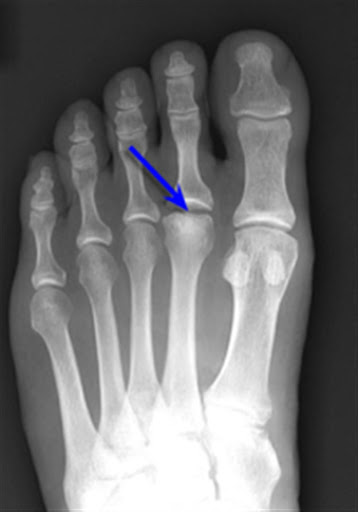Having a Freiberg’s infraction means that the blood supply to the end of one of the long bones called metatarsals in the feet has been interrupted.
 When a bone is left without a sufficient blood supply for long enough, avascular necrosis occurs – meaning that the bone tissue dies, and the bone end often develops tiny breaks and collapses. This means that a Freiberg’s infraction can turn serious if left untreated.
When a bone is left without a sufficient blood supply for long enough, avascular necrosis occurs – meaning that the bone tissue dies, and the bone end often develops tiny breaks and collapses. This means that a Freiberg’s infraction can turn serious if left untreated.
Signs that you may have a Freiberg’s infraction include feeling pain at a specific area of the ball of the foot that tends to worsen over the course of many weeks. Most often, it is the second or third metatarsals that are affected. As the pain worsens, we see many people adapt a limping gait in order to help reduce pain as they walk. Wearing heeled shoes may become too painful, and the affected joint may become stiff or swollen.
The cause behind a Freiberg’s infraction is thought to be either from damage to the vascular supply to the bone, or from trauma to the bone, which can occur from one large traumatic event (like jumping down from a high surface) or repetitive microtrauma over time (like running). Both of these can lead to damage to the bone and joint, interfering with the structural integrity in the area, and disrupting the blood supply. Anatomical features like having a long second metatarsal bone may also play a role.
Can you fix it?
Yes, as long as the infraction is picked up early enough, it can usually be successfully treated by your podiatrist. As your risk of having another infraction is greater after your first, our podiatrists always look at all the factors that may have contributed to a reduced blood supply to the specific bone, and put the right measures in place to help reduce the likelihood of it recurring as part of your treatment plan with us. From an appointment with our Masterton podiatrists, you can expect:
- To have a thorough understanding about your condition and the likely reasons that it has developed
- To know what you should be doing to support your recovery at home, and what you should be avoiding that may make it worse
- To have a personalised treatment plan that outlines the steps of your care and what you can expect
- To have a team of experienced, knowledgeable podiatrists behind you to keep you fully supported throughout your care
How is a Freiberg’s infraction treated?
The first step to a successful treatment is to accurately diagnose your infraction, as this condition shares similar symptoms with other podiatric conditions including a stress fracture, a Morton’s neuroma, a plantar plate disruption or capsulitis. This will be done as part of your biomechanical assessment, where we may also refer you for x-ray imaging to understand the severity of the condition. If your condition is very advanced, we may need to refer you to an orthopaedic surgeon.
The start of your treatment will involve off-loading of the affected bone and joint to optimise the blood supply available to it. This can either be done through custom foot orthotics, or the use of a moon boot or similar device. Ice and anti-inflammatory medication may be used to help manage your pain in the meantime, and if you’re using orthotics, you’ll need to adjust the kinds of activities that historically overloaded the affected joint, like running sports.
Once your symptoms are resolved, we’ll support you in your return to normal activity. It is highly likely that you’ll need to wear custom foot orthotics with padding and special modifications at the forefoot to best support your foot and the way it is loaded – especially if your natural foot biomechanics have a tendency to overload your forefoot. This should be paired with good, supportive footwear, while high heels should be avoided. Physical therapy such as stretching and strengthening, as well as foot mobilisation, is also likely to be used.
Life after treatment
While we have great success with treatment, the nature of a Freiberg’s infraction means that you have a high risk of developing osteoarthritis in the affected joint in the future. We will explain exactly what you may expect and the warning signs to look out for, and our care will centre around keeping you active, pain-free and happy for the years to come.
FAQs
Will I need to modify my activities or restrict weight-bearing during the treatment period?
In many cases, activity modification and temporary weight-bearing restrictions are recommended to reduce stress on the affected foot. Your podiatrist may suggest avoiding high-impact activities or provide you with a walking boot or crutches to offload pressure from the affected area.
Are there any specific exercises or physical therapy techniques that can help with the management of Freiberg’s Infarction?
If physical therapy may be beneficial for Freiberg’s Infarction, this will be decided on a case-by-case basis. Your podiatrist can guide you through exercises, if appropriate, aimed at improving foot strength, range of motion, and flexibility. They may also provide techniques to optimise gait mechanics and reduce stress on the affected area.
Can Freiberg’s Infarction be managed or improved without surgery?
Yes, non-surgical management options are available for Freiberg’s Infarction that aim to alleviate symptoms and promote healing without the need for surgery.
What does the surgical treatment for Freiberg’s Infarction involve?
Surgical treatment for Freiberg’s Infarction is typically considered when conservative measures fail or in more advanced cases. The specific surgical procedure will depend on the severity and location of the condition. It may involve removing damaged or necrotic bone, realigning the joint, or fusing the affected joint to reduce pain and restore function.
How long does it typically take to recover from treatment for Freiberg’s Infarction?
The recovery time can vary depending on the severity of the condition and the treatment provided. Conservative management may require several weeks to months for symptom relief and healing. Following surgery, it may take several months to a year for complete recovery, including rehabilitation and physical therapy.
Are there any complications or long-term effects associated with Freiberg’s Infarction?
In some cases, Freiberg’s Infarction can lead to long-term complications such as joint stiffness, arthritis, joint deformity, or chronic pain. However, with appropriate treatment and management, these complications can often be minimised or prevented.
Can Freiberg’s Infarction lead to arthritis or other foot conditions?
Freiberg’s Infarction can potentially lead to post-traumatic arthritis in the affected joint if left untreated or not managed effectively. This is why it’s essential to seek appropriate medical care to reduce the risk of developing secondary foot conditions and complications.

